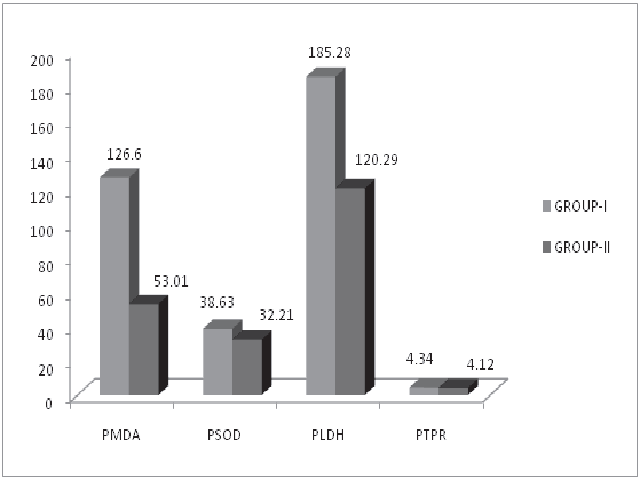Malondialdehyde (MDA) and Superoxide Dismutase (SOD) Levels – Distinguishing Parameters between Benign and Malignant Pleural Effusions
DOI:
https://doi.org/10.5530/ax.2012.2.2.2Keywords:
Pleural effusion, Malondialdehyde, Superoxide dismutase, Lactate dehydrogenaseAbstract
Introduction: Pleural effusion is a common clinical disorder and is either a manifestation or a complication of one or other respiratory or non-respiratory diseases. Increased oxidative stress participates in the pathogenesis of both airways and parenchymal lung diseases. There is a critical balance between free radical generation and antioxidant defences. The local production of free radicals and the role of oxidative stress in the pathogenesis of pleural effusions have not been extensively studied. Objective: To assess the levels of malondialdehyde (MDA), superoxide dismutase (SOD), total proteins (TPR) and lactate dehydrogenase (LDH) in pleural fluid and serum, also to analyse that whether malondialdehyde and superoxide dismutase can be used as potential markers for distinguishing between benign and malignant pleural effusion. Research Design and Methods: 96 participants were included in this prospective study and were divided into two groups. Group-I consisted of 48 cases of malignant pleural effusion and group-II consisted of 48 cases of benign pleural effusion. Results: Mean serum levels of malondialdehyde, superoxide dismutase, lactate dehydrogenase and total proteins in malignant (group-I) were 131.88±12.17 nmol/ml, 39.28±5.28 U/ml, 285.20±33.06 IU/L, 6.0±0.67 gm % and in benign (group-II) were 72.83±5.58 nmol/ml, 34.35±3.61 U/ml, 227.69±10.01 IU/L, 6.13±0.58 gm % respectively. In pleural fluid mean levels of malondialdehyde, superoxide dismutase, lactate dehydrogenase and total proteins malignant pleural effusion (group-I) were 126.83±12.26 nmol/ml, 38.63±5.67 U/ml, 185.28±21.48 IU/L, 4.34±0.84 gm % and in benign pleural effusion (group-II) were 53.01±8.92 nmol/ml, 32.21±3.27 U/ml, 120.29±15.37 IU/L, 4.12±0.47 gm % respectively. This study showed statistically significant increase in malondialdehyde levels (p-value < 0.001), activities of superoxide dismutase enzymes (p-value < 0.001) and lactate dehydrogenase levels (p-value < 0.001) in malignant pleural fluids when compared to the benign pleural fluids. Non significant change was observed in total protein levels (p-value > 0.01) in malignant pleural fluids when compared to the benign pleural fluids. Conclusion: Oxidative stress is increased in malignant pleural effusion malondialdehyde and superoxide dismutase being oxidative stress markers, can be used for differentiating between malignant and benign pleural effusions.
Downloads
Metrics





